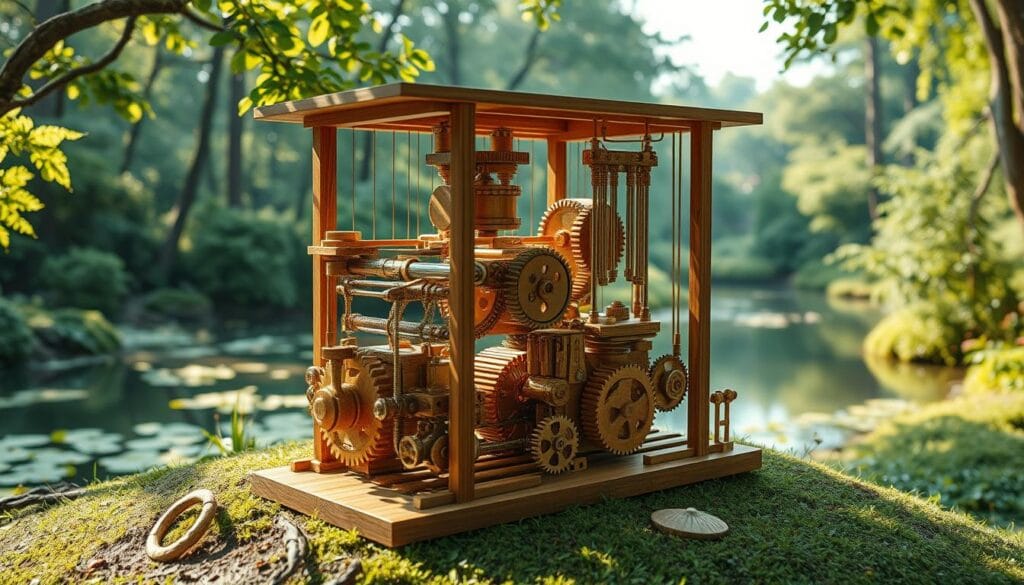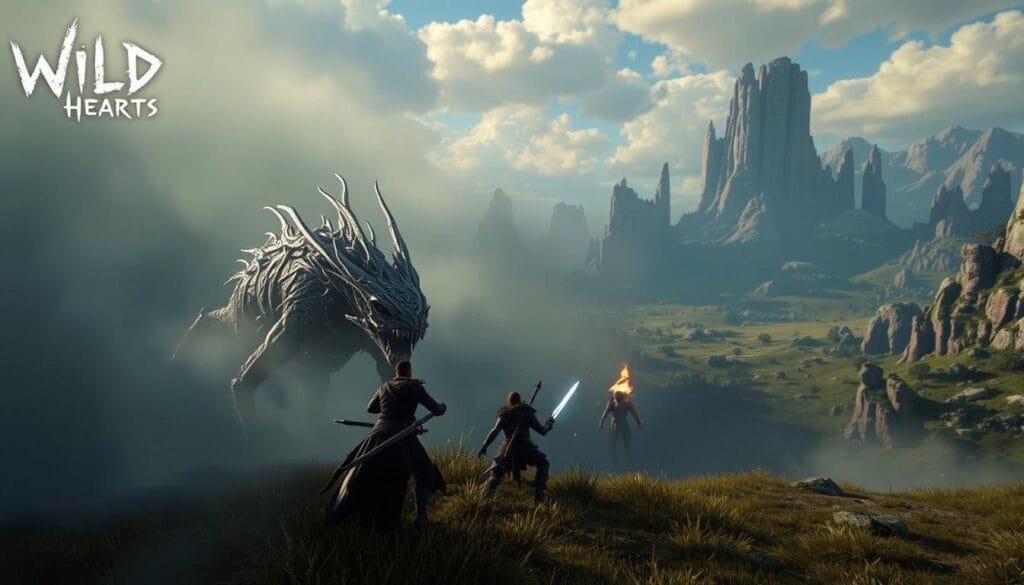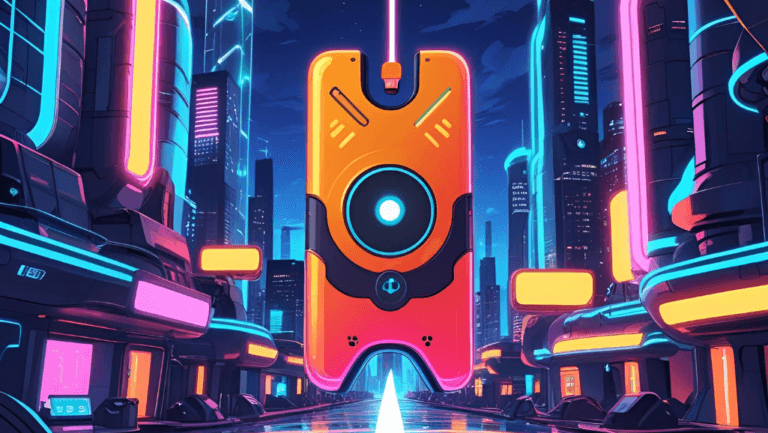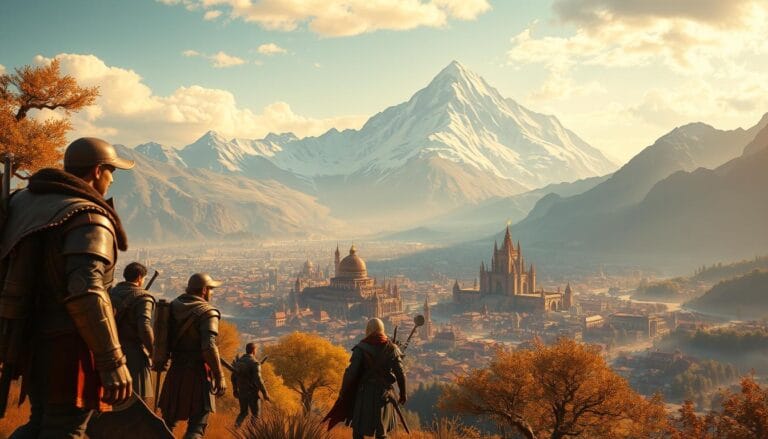Step into a hunting experience that challenges how you approach combat and construction. This wild hearts game review introduces a co-op-focused title from Omega Force and EA Originals that pairs massive elemental beasts with a clever karakuri building system.
Azuma’s season-shifting arenas feel alive, and Minato serves as a bustling hub between fights. The genre’s familiar loop—mission, craft, escalate—lands here with added mobility and on-the-fly invention.
Across hours of play, expect to learn kemono patterns, grow your weapon and armor trees, and use Celestial Thread tools to reshape encounters. Creativity often wins: stack crates, rig springboards, and turn hazards into advantages under pressure.
Performance hiccups can appear in heavy snow and some textures, but bold art direction, stirring music, and confident design keep the journey compelling. This piece will show who will love the series and why the systems reward persistence and invention.
Key Takeaways
- Karakiuri construction reshapes fights into creative puzzles.
- Azuma’s biomes and Minato hub enrich the world and pacing.
- The title trims busy prep in favor of mobility and reads.
- Technical dips appear in snow-heavy scenes, but art and score stand out.
- Play solo or co-op: experimentation and mastery pay off across hours.
Quick Verdict and Who Should Play Wild Hearts
This entry focuses on speed and creativity, blending clear lessons with on-the-fly building. The core loop mirrors classic hunting formulas: chase kemono, break parts, and upgrade weapon and armor trees. But it trims tedious prep and cluttered menus so you spend more time fighting and inventing.
Is it worth your time right now?
Yes—if learning ferocious patterns and turning them into opportunities excites you, this title is worth your time. The karakuri toolkit makes each failed attempt a chance to experiment rather than repeat the same motions.
Best fit: Monster Hunter veterans vs. new hunters
Veterans of Monster Hunter will find the mission flow familiar and satisfying, but with less friction and a higher emphasis on mobility. New players get an easier on-ramp thanks to a jump button and forgiving co-op revival rules.
- Co-op play smooths over sudden difficulty spikes and lowers the times you’ll feel gear-gated.
- Solo runs are possible, but the game truly shines when players share tactics and builds.
- The story and hub pacing help your upgrades feel meaningful between each hunt.
For a deeper look at how this approach plays out, see the full IGN take.
Wild Hearts Game Review: What Sets It Apart
Instant engineering during battles gives this release a fresh, tactical heartbeat few in the genre match.
The karakuri system is the defining tool here. You place crates, walls, springs, torches, gliders, and ziplines in seconds. Those pieces can be used mid-fight or as world utilities that change how you explore Azuma.
Karakuri ingenuity
Fusion karakuri combine basics into dramatic constructs. Build bulwarks to launch a charging monster or line up springs to drop a giant hammer.
The unlock tree opens drying racks, wheel mounts, and cosmetics. The progression feels rewarding, not grindy.
Streamlined systems
Developed by Omega Force with Koei Tecmo and EA Originals, the title trims busywork found in similar games.
There are fewer items to juggle and less pre-hunt clutter. The flow pushes you to learn attacks and land the right attack at the right time.
Mature tone and presentation
The story leans adult without losing wonder. Writing and an authentic English dub add weight to the stakes.
- Play creatively: think in setups, not only damage numbers.
- Move freely: use karakuri to shape fights in the air and on the ground.
- Grow meaningfully: the tree gives new ways to solve fights, not just small stat boosts.
World, Story, and Atmosphere of Azuma
Azuma unfolds like a living painting, its seasons changing the stakes of each hunt. Snow, bloom, and storm alter routes and enemy patterns. The setting feels handcrafted and alive.
The plot centers on the Celestial Thread, a force woven into your hunter and the land. It draws creatures into conflict, powers karakuri, and explains why parts and items matter beyond stats.
Minato and the Thread
Minato acts as a warm, bustling hub. Smiths, vendors, and allies give meaning to raw drops and refined parts. You return here between missions to craft, trade, and plan.
The presentation lifts small moments. English voice work fits accents, and the music swells like a film score. Quiet interludes feel as weighty as big confrontations.
- Seasons matter: biomes refresh each visit and guide your choices.
- Story through systems: Celestial Thread ties upgrades to narrative beats.
- Crafting as reward: collecting items and parts stitches progress into the series’ larger arc.
Gameplay and Combat Feel: From First Hunt to Mastery
Combat here rewards curiosity: each encounter is a classroom that teaches timing, pattern reading, and trust in your tools. Early runs are cautious. Later hunts feel like choreography.
The dance of reads, dodges, and commitment
Fights play out as a readable dance where well-timed dodges, smart attacks, and selective commitment matter. Learn kemono tells, respect long animations, and you will convert panic into precision.
Difficulty spikes and how co-op reshapes the fight
Co-op changes the equation. Revives do not eat the team death counter, so players can be bolder. Teams layer builds, utilities, and karakuri to open windows solo runs rarely see.
Tsukomo support, healing flow, and mobility tools
Your Tsukomo quietly helps by taunting, tossing crates, and dropping healing totems. Healing requires a short drink animation, making position and timing vital.
- Mobility frees the air: jump, glide, and wall-launch to punish and reposition.
- Environmental refills and karakuri sprays reward planning and set-piece thinking.
- Fireworks blind flyers; bulwarks stun chargers—use the arena as a weapon.
In the end, each hunt teaches a new way to hit a weak point, dodge safely, or fuse a construct that ends a phase. The result is gameplay that celebrates precision and invention over raw numbers.
Weapons, Armor, and Progression Depth
Your toolkit defines play: some weapons demand aerial finesse, others raw commitment.
Start broad and find your fit. The arsenal spans eight distinct types — Katana, Claw Blade (aerial tether and slicing), greatsword, hammer, a parry-centric umbrella, firearm, and more. Each weapon rewrites timing and tempo.
The weapon tree pushes specialization. Branches tie into monster drops and story beats so upgrades feel earned. Choose elemental paths and tailor your loadout for specific threats.
Armor paths add identity. Human and kemono variants change looks and passives. That lets you match defenses to playstyle and to the elemental matchups you expect.
“Progression here rewards creativity over raw stats.”
- Dragon Pits raise the number of placeable items like tents and zip lines.
- The karakuri unlock tree holds hundreds of options that expand utilities and healing tools.
- Stamina and healing access can be buffed through unlocks to sustain longer fights.
In short, the system blends weapon choice, armor customization, and utility growth so each climb of the tree sharpens how you hunt and build in this game.
Monsters, Variety, and Mission Structure
Kemono design mixes real animals and elemental themes to create encounters that feel both familiar and startling.
The creature roster shines in concept. Fumebeak and Pearlbeak blend quilled crow anatomy with poison and ice. Deathstalker moves like an ice wolf. Lavaback hits like a volcanic gorilla. These monsters show unpredictable behavior and memorable animations.
That said, the number of distinct beasts is modest. The title leans on variants to extend life. New elements and movesets keep repeat fights from going stale, but you will face some enemies many times when farming rare parts.
Killer encounters, focused variety
The hunt loop follows a classic chase-and-fight rhythm familiar to Monster Hunter fans. Track, engage, break parts, and craft better gear.
Escalation and co-op flow
Mid-campaign buffed variants push execution and composure. Some foes hit like freight trains, so co-op and quick portals are smart choices. Players can drop in and share wins with minimal friction.
- Design triumph: kemono feel alive and teach through their moves.
- Focused roster: fewer unique monsters, more meaningful variants.
- Reward loop: broken parts feed upgrades and sharpen weapon familiarity.
“Spectacle and readability keep the loop exciting, even when variety is lean.”
Performance, Visuals, and Technical Polish
Frame pacing and visual clarity determine whether a tense fight feels fair or frustrating. Console players get clear choices: PS5 performance mode favors 60 fps for smoother reads, while the 30 fps quality mode sharpens detail but makes fast reads a bit harder.
Disable heavy motion blur to clear the air and sharpen reactions. PC users should expect frame dips during snowstorms, occasional texture pop-in, and rare lighting flicker.
Console modes, PC quirks, and snowstorm slowdowns
Multiplayer can stutter a bit for remote players; core inputs stay responsive. Tuning settings during intense weather often stabilizes the experience and keeps fights readable.
Audio excellence: music swells and strong voice work
The soundtrack soars in big moments, and the English dub earns praise for authentic casting. These elements lift the presentation when technical issues pop up.
- Tip: Lower effects in heavy snow to reduce frame drops.
- Art direction holds up—painterly biomes and strong silhouettes hide some muddy textures.
- Compared to Monster Hunter, this package feels like a bold first entry with a few rough edges but hours of reward.
“Tweak, play, and the strengths reclaim center stage.”
Conclusion
Combat and construction sit side by side here, so a clever setup can matter as much as a perfectly timed attack.
This wild hearts game from Omega Force and Koei Tecmo blends monster hunting loops with a deep karakuri system and a wide unlock tree.
Across the hours, eight weapon types, armor paths, Dragon Pits, and healing items give players tools to refine play. The kemono and their attacks dazzle, even if the roster is a bit lean.
Expect some technical issues — snow slowdowns, pop-in, and occasional net hiccups — but also strong audio and voice work that lift the world.
In short: this is a confident hunting game that rewards creativity, patience, and teamwork. Bring ideas, try new builds, and the payoff arrives right after the rough times.






















